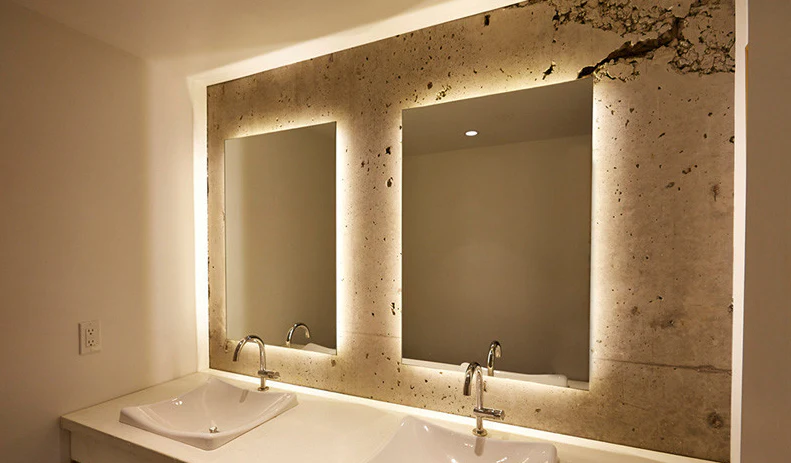In the age of smart living and sleek aesthetics, the shift from traditional mirrors to LED mirrors for modern home design is more than a fleeting trend—it’s a practical evolution in interior design. As homeowners seek style, function, and efficiency, LED lighted mirrors have emerged as a preferred choice in bathrooms, bedrooms, dressing areas, and even entryways. But what exactly sets them apart from their traditional counterparts? This in-depth blog delves into the advantages of LED mirrors and why they’re fast becoming essential elements in the design of contemporary spaces.
Aesthetic Evolution: Modern Appeal of LED Mirrors
One of the most immediate and striking differences between LED and traditional mirrors is the aesthetic value they bring to a room. Traditional mirrors, while functional, often rely on external lighting—such as wall sconces or overhead bulbs—that can create harsh shadows or uneven illumination. LED mirrors, on the other hand, come integrated with built-in lighting systems that provide soft, even, and flattering illumination. This makes them not only more visually pleasing but also significantly more functional for everyday tasks such as grooming, applying makeup, or shaving.
The minimalist design of LED mirrors aligns perfectly with modern home aesthetics. Clean lines, edge-to-edge glass, and seamless integration into walls give LED mirrors a futuristic appearance that complements contemporary architecture. Whether mounted or recessed, these mirrors offer a clutter-free and refined look. They often feature customizable shapes and lighting tones, allowing homeowners to create focal points or enhance a room’s ambiance with a single piece.
Enhanced Functionality: Beyond Just Reflection
LED mirrors are more than just mirrors with lights—they’re multifunctional tools engineered for convenience and modern lifestyles. Many models come with features like touch sensors, dimmable lighting, anti-fog systems, Bluetooth connectivity, and even built-in clocks or weather displays. These additions transform what was once a simple reflective surface into a tech-savvy hub that integrates effortlessly with smart home systems.
For example, a backlit LED mirror in the bathroom can eliminate the need for additional lighting fixtures. With dimmable options, users can adjust the light intensity to suit morning routines or evening relaxation. Anti-fog technology ensures the mirror remains clear even after a hot shower, removing the need for constant wiping. These features significantly improve the daily experience, offering convenience and efficiency that traditional mirrors simply can’t match.
Furthermore, many LED mirrors are designed to be energy-efficient, with long-lasting light sources that consume less power than traditional bulbs. This makes them an eco-friendly choice, aligning with the increasing demand for sustainable living solutions in modern home design.
Energy Efficiency and Sustainability
One of the core advantages of LED mirrors for modern home design lies in their energy efficiency. Traditional mirrors often require additional lighting fixtures that rely on incandescent or fluorescent bulbs. These older technologies consume more electricity and have shorter lifespans, contributing to higher energy bills and increased environmental impact.
LED lighting, by contrast, uses up to 80% less energy than traditional bulbs and can last up to 50,000 hours. This means fewer replacements, reduced maintenance costs, and a lower carbon footprint. The energy-efficient nature of LED mirrors makes them an ideal choice for eco-conscious homeowners looking to reduce their environmental impact without sacrificing style or functionality.
In addition, many LED mirrors use recyclable materials and are designed with low-heat emission properties. This not only enhances safety, especially in households with children, but also contributes to maintaining a stable room temperature—an underrated benefit in climate-controlled environments. The durability of LED lighting also ensures that the mirror remains a reliable feature in the home for years to come, unlike traditional setups that may require frequent bulb changes or fixture updates.
Space Optimization in Modern Interiors
Another compelling reason LED mirrors are favored in modern home design is their ability to save space and simplify layouts. In smaller urban homes, apartments, or condos where square footage is at a premium, maximizing every inch matters. LED mirrors help in achieving this goal by combining lighting and reflective surfaces into a single, compact unit. This eliminates the need for bulky light fixtures or standalone vanities, creating more open and breathable environments.
Some LED mirrors also incorporate storage behind or around the frame, further aiding in space-saving. This is especially useful in bathrooms where minimalism and organization are essential. Wall-mounted LED mirrors help keep countertops clear while still providing ample lighting and functionality.
In open-concept spaces or multipurpose rooms, LED mirrors can act as both decorative and functional elements. For instance, an LED mirror in a hallway can brighten a dark corner while providing a place for last-minute outfit checks. In bedrooms, they can serve as elegant vanity setups without occupying excessive room. These design advantages make LED mirrors an intelligent choice for contemporary lifestyles where form and function go hand in hand.
Long-Term Value and Investment
While the upfront cost of LED mirrors may be higher than traditional mirrors, they offer long-term value that makes them a wise investment. The integration of features like smart lighting, energy efficiency, and durability ensures that homeowners save on utility bills and maintenance over time. In essence, you’re not just buying a mirror—you’re investing in a long-lasting, multifunctional fixture that enhances your daily routines and adds measurable value to your property.
Homebuyers today are increasingly drawn to modern amenities, and LED mirrors can be a standout selling point. Their stylish appearance, coupled with practical benefits, contributes to a sense of luxury and forward-thinking design. Whether you’re remodeling a bathroom for resale or upgrading your bedroom for personal comfort, adding LED mirrors signals quality and modern sensibility.
Moreover, as technology continues to advance, LED mirrors are likely to become even more integrated with smart home systems. Voice control compatibility, app-based customization, and AI-driven lighting adjustments are already entering the market. Choosing LED mirrors now means you’re future-proofing your home for years to come.
Conclusion
The comparison between LED and traditional mirrors clearly tilts in favor of the former, especially for those focused on designing modern, efficient, and stylish living spaces. LED mirrors for modern home design are more than just aesthetic upgrades—they are comprehensive solutions that blend technology, sustainability, and design. From their visual appeal and functional enhancements to their energy-saving features and space optimization, LED lighted mirrors represent the evolution of a household essential into a smart home asset.
Whether you’re building a new home, renovating an outdated bathroom, or simply seeking to elevate your space, choosing LED mirrors is a decision rooted in both logic and luxury. They not only reflect your image—but also your commitment to modern living.





























